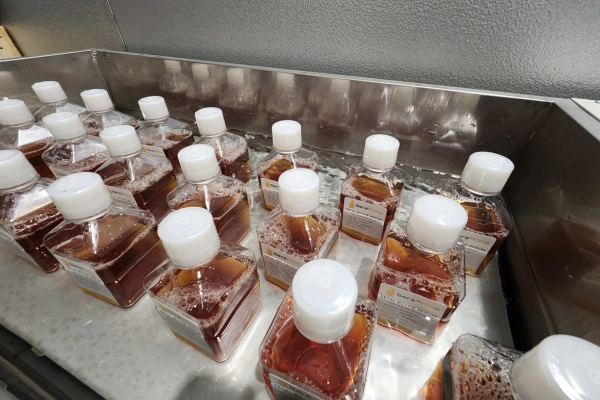Heat-inactivated (HI) Fetal Bovine Serum (FBS) is one of the highest-quality serum products offered by SeraPrime with over 20 years of industry experience. FBS remains a popular media supplement because it provides a wide array of functions in cell culture, and the heat-inactivated serum provided by SeraPrime is designed to meet the diverse needs and requirements of every individual, laboratory, and organization around the world conducting state-of-the-art research.
To ensure the highest levels of quality compliance, our FBS is manufactured in an ISO class 13485 Approved Facility and filtered in an ISO class 5 environment exceeding industry standards. Our FBS also allows for product treatments such as heat inactivation for specific research that requires the removal of complement activity – if you think that your research needs heat activation, read the following article to learn more about the process, how it works, its benefits, and whether it is truly necessary for your applications.
What is Heat Inactivation for FBS?
Some cell culture research is sensitive to complement activity – the objective of heat inactivation is to destroy complement activity in the serum without affecting the growth-promoting characteristics of the product. Complement activity that is destroyed includes certain proteins that make up the innate immune system that contributes to inflammation and can opsonize pathogens. In addition to interacting with pathogens directly, complement proteins can also bind antibody-antigen complexes. Interactions between complement proteins and antibodies may interfere with the binding of target molecules in immunoassays, making the inactivation of serum complement proteins a necessary step in certain immunological applications.
Unfortunately, if performed incorrectly, heat inactivation can also destroy growth-promoting factors and degrade valuable biomolecules, such as vitamins and amino acids.
When is Heat Inactivation of Serum Necessary?
At one time, heat inactivation was considered necessary because of concerns over the presence of contaminants in serum. However, considering the risks it poses to the serum, this procedure should only be performed if required for optimal cell growth. Be sure to evaluate whether heat inactivation is applicable and appropriate for your research before proceeding, as many protocols still call for serum to be subjected to heat treatment prior to use without consideration as to whether it remains desirable.
Benefits of Heat Inactivated FBS
Serum used to be filtered through 0.45um or 0.22um filters, and thus there was a valid concern that adventitious agents such as mycoplasma could still be present after filtration. In such cases, heat inactivation could help to reduce the potential for obtaining contamination through this route. Today, serum is typically filtered through 0.1um or even 0.04um porosity membranes which reduces the need for heat inactivation processes in many modern cell culture studies. However, active compliments can still have an effect in some research. Active complement can participate in cytolytic events, contract smooth muscle, release histamine from mast cells and platelets, and activate lymphocytic and macrophage cells. Applications where heat-inactivated serum is recommended include immunological studies and culturing of embryonic stem cells (ESCs), insect cells, and smooth muscle cells.
How to Perform Heat Inactivation
Preparation
- Thaw the desired Serum until at room temperature – if thawed in a refrigerator, allow the serum to set at room temperature.
- Heat agitating water bath (set at 56°C) and fill with water to ensure bottles will be immersed to cover the level of the serum.
- Gently mix the contents of the bottle/serum thoroughly before placing it in the water bath.
- It is recommended to have a weight to secure each bottle and prevent tipping while the water bath is agitating.
Heat Inactivation
- Once the water bath temperature reaches 56± 2°C, place the serum bottles in the water bath (include a control bottle with a thermometer to monitor the internal temperature of the serum).
- Set the water bath to agitate or swirl the bottles every 10 minutes to ensure the serum remains uniform. NOTE: Agitation prevents gelling and will promote uniform heating.
- When the control bottle reaches an internal temperature of 56± 2°C, begin the timer for 30 minutes.
- After 30 minutes, remove the bottles and transfer to the cooling rack/space. Cool the bottles for at least 1 hour before aliquoting or returning to the freezer.
Source World-Class Fetal Bovine Serum
If your research demands the highest-quality fetal bovine serum, whether or not you intend to utilize heat inactivation, contact the industry-leading manufacturer at SeraPrime. We are the trusted provider for some of America’s most reputable institutions, including Harvard, MIT, St. Jude Children’s Research Hospital, Stanford, and large Pharma. We stand by our ethical collection of FBS using U.S.-inspected and established facilities and USDA-approved countries for animal health inspection. We ensure individual documentation and pre-test inspection for endotoxins, hemoglobin, and viruses, in order to ensure only the most quality products are used in your research. Contact SeraPrime today to learn more about why our clients love working with us!

